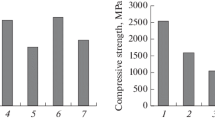Conclusions
-
1.
An investigation of the shrinkage of bronze specimens with boron additions demonstrated that boron, being a surface-active element with respect to copper, sharply increases the shrinkage of bronze, which is evidently due to the generation of additional defects in interparticle contact zones during the diffusion of boron into the particles.
-
2.
The greatest improvement in the shrinkage, and also strength, of the alloys occurs approximately at the limit of solubility of boron in copper.
-
3.
As a surface-active element, boron reduces the tendency for grain growth during sintering by forming an adsorption layer on the grain surface.
-
4.
Experiments demonstrated that boron in amounts corresponding to its maximum solubility in copper increases the wear resistance of tin bronze.
-
5.
The addition of boron simplifies production of dense parts in tin bronze by eliminating all extra pressing and sintering operations.
-
6.
As a result of these investigations, it may be concluded that surface-active substances added to powder-metallurgical and other materials will lead to grain refinement, increased shrinkage, and improvement in the properties of these materials.
Similar content being viewed by others
Literature cited
M. V. Pridantsev, Stal', No. 8 (1955).
Bungardt, Stahl Eisen, No. 23 (1953).
S. M. Vinarov, Dokl. Akad. Nauk SSSR,55, No. 9 (1947).
S. M. Vinarov, Izv. Akad. Nauk SSSR, Otd. Tekhn. Nauk, No. 6 (1948).
V. M. Chursin, Dissertation [in Russian], Moscow Institute of Gold and Nonferrous Metals (1955).
M. V. Pridantsev, Effect of Impurities and Rare-Earth Elements on the Properties of Alloys [in Russian], Izd-vo Lit. po Chernoi i Tsvetnoi Metallurgii, Moscow (1962).
V. I. Arkharov, Investigation of Diffusion and Internal Adsorption in Metals and Alloys [in Russian], Tr. Inst. Fiz. Metal., No. 16, Izd-vo AN SSSR, Moscow (1955).
A. P. Smiryagin and O. S. Kvurt, Metallography and Treatment of Nonferrous Metals and Alloys [in Russian], Tr. Gos. Nauchno-Issled. i Proektn. Inst. Splavov i Obrabotki Tsvetn. Metal., No. 24, Metallurgizdat (1965).
M. L. Bemshtein and A. G. Rakhshtadt (editors), Metallography and Heat Treatment of Metals and Alloys [in Russian], Vol. 1 (1961).
S. S. Gorelik, Recrystallization of Metals and Alloys [in Russian], Moscow (1967).
V. I. Dobatkin, in: Light Alloys [in Russian], No. 1, Izd-vo AN SSSR, Moscow (1958).
Ya. E. Geguzin, Microscopic Defects in Metals [in Russian], Metallurgizdat, Moscow (1962).
V. V. Skorokhod, Poroshkovaya Met., No. 2 (1968).
M. Yd. Akhmetov, Za Tekhn. Progress, No. 11 (1965).
Author information
Authors and Affiliations
Additional information
Translated from Poroshkovaya Metallurgiya, No. 5(89), pp. 60–66, May, 1970.
Rights and permissions
About this article
Cite this article
Filatova, N.A., Polushko, A.P., Luzhanskaya, N.Y. et al. Effects of boron on the properties of sintered tin bronze. Powder Metall Met Ceram 9, 400–405 (1970). https://doi.org/10.1007/BF00796509
Received:
Issue Date:
DOI: https://doi.org/10.1007/BF00796509



